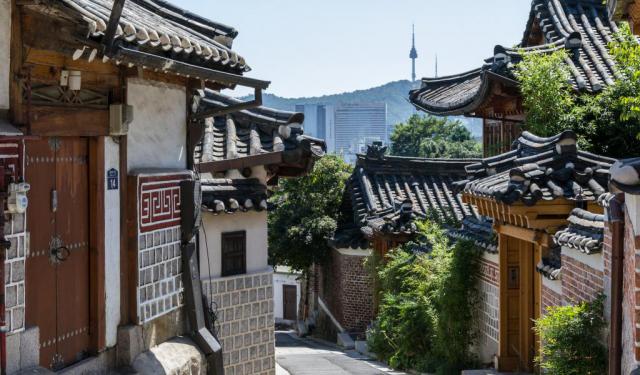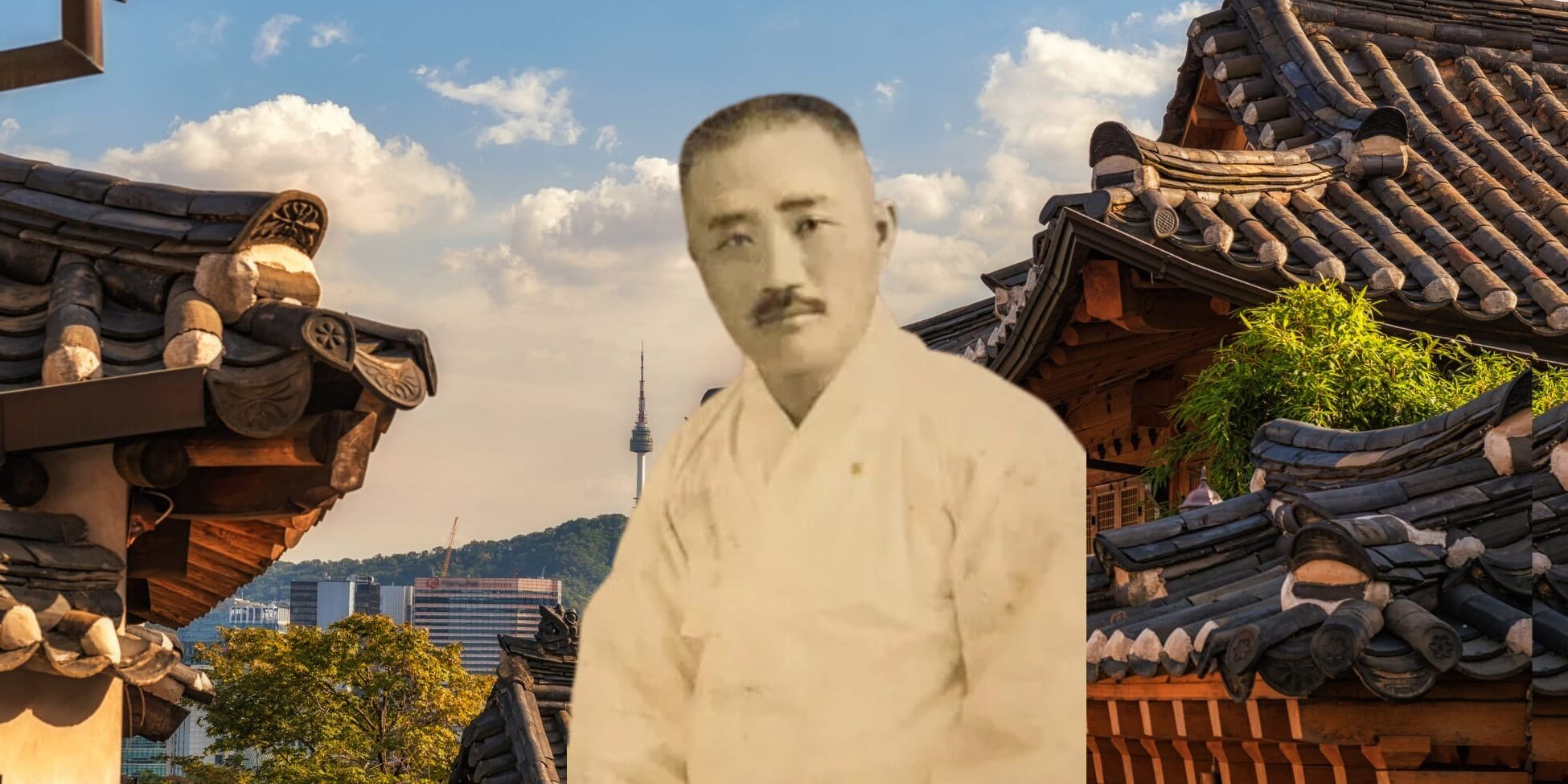On a ridge between Seoul’s two royal palaces lies a cluster of tiled roofs and winding alleys, full of Korean traditional homes called hanok. Tourists know it as Bukchon Hanok Village, a postcard of old Korea framed against the city’s glass and steel towers. But this picturesque neighborhood hides an amazing story of determination, resistance, and reinvention that most people don’t know about.
A Patriot with a Developer’s Eye
From 1910 to 1945, Korea lived under Japanese colonial rule, subject to a regime determined to erase its culture and fold the nation entirely into the empire of Japan. By the 1920s, Japanese settlers in Seoul owned more land than Koreans. Japanese-style houses were multiplying rapidly, and Koreans were losing their hold on the city’s most prized districts. Premium plots in places like Myeongdong and Yongsan were snapped up, and modern Japanese homes rose in neighborhoods once reserved for the traditional hanok estates of Korean aristocrats.
Koreans were outraged by the gradual swallowing up of Seoul by foreigners, but there was little they could do until a man named Jeong Se-kwon came up with a plan. Channeling his outrage into a mission to preserve Korean land for Koreans. He believed there was strength in numbers, and that if enough Koreans became homeowners, they could block Japanese encroachment. Armed with a fierce sense of purpose, he founded what is regarded as Korea’s first modern development company and began building “urban hanok.” These were streamlined versions of traditional hanok, wired for electricity, fitted with glass, and compact enough to be affordable for middle-class families.

A family photo of Jeong Se-kwon (seated left) from the 1930s. Photo: Ima
Jeong is remembered as Korea’s first modern land developer because he professionalized housing construction and subdivision on a scale Seoul had never seen. His company was so prolific that it produced more than 300 hanok each year. In addition to Bukchon and Ikseon-dong, Jeong built modern-style hanok complexes throughout northern Seoul, including Bongik-dong, Seongbuk-dong, Hyehwa-dong, Changsin-dong, Seodaemun, Wangsimni, and Haengdang-dong.
These were the first modernized hanok, equipped with running water and electricity at a time when such conveniences were rare. The design emphasized ventilation and sunlight, making it healthier and more livable than anything that had come before. Jeong pushed innovation even further. He reimagined the layout of traditional interiors, shifting the placement of the guest room, kitchen, and storage areas for greater efficiency. He added glass doors to the main hall and fitted metal visors to the eaves that performed as gutters. The result was a new type of hanok: large enough for a family of six, organized around a central living space, and oriented south to maximize light. This model became the blueprint for the large-scale hanok complexes that would eventually shape neighborhoods like Bukchon.
Jeong believed deeply that modern housing should not be the privilege of the wealthy. He published articles declaring that ordinary people deserved the same conveniences, and he devised a radical plan to make it possible. Instead of demanding lump-sum payments that few families could afford, he let buyers move in first and pay in monthly or yearly installments. It was one of Korea’s earliest experiments in accessible housing finance, and it opened the doors of Bukchon to a far wider cross-section of society.

A hanok neighborhood in Seoul circa the 1920s.
His activism extended well beyond architecture. Jeong poured his increasing wealth into nationalist causes, most notably the Korean Language Society, which worked to preserve Hangul at a time when the colonial authorities sought to erase it by forcing Koreans to speak Japanese. That commitment came at a devastating cost. When the police cracked down on the Society in the 1940s, Jeong was arrested, tortured, and stripped of his wealth. His properties were seized and his business ruined. His life as Korea’s pioneering land developer was broken by the very regime he had worked so hard to resist.

Bukchon today.
Bulldozers at the Gate
Liberation in 1945 did not bring security to Bukchon. By the 1970s, Jeong Se-kwon was long forgotten, and Seoul was modernizing at breakneck speed, chasing highways and high-rises. Across the capital, thousands of hanok were flattened in the name of progress. Bukchon escaped full clearance, but not unscathed. Its alleys thinned as redevelopment nibbled away.
As early as 1976, city officials began to recognize what was at stake. Bukchon was reclassified as a preservation zone, height restrictions were imposed, and grants were issued for repairs. But even then, people found ways around the laws and the city found it hard to enforce the rules. In the 1990s, restrictions loosened, and developers returned in force, tearing down original hanok under the mantra of modernization. By the turn of the millennium, Bukchon teetered between survival and erasure.
The Foreign Neighbor Who Fought Back
In the early 2000s, British journalist David Kilburn and his Korean wife, Jade (Keum-Ok) Kilburn, moved into a hanok in the Bukchon area. What they witnessed around them was a slow-motion destruction of a neighborhood steeped in so much historical beauty. Demolitions were the worst, but most were dying a death by a thousand cuts as the wealthy bought up homes and started modern renovations while city officials often looked the other way.
In the face of opposition from neighbors and developers alike, the Kilburns decided to fight back. With cameras, websites, petitions, and press interviews, theu]y transformed their street-level struggle into an international cause. Their campaign forced uncomfortable questions into the open and even landed in the New York Times. Eventually the neighborhood was saved and protected from future developers. But many questions remained for the residents who insist that the spirit of their hanok can live in harmony with modern designs and comforts.
“What’s being lost isn’t just architecture. It’s memory, it’s continuity, it’s Seoul’s own story.” — David Kilburn

Bukchon today: beautiful modern hanok can be rented on Airbnb that offer modern conveniences amidst a traditional Korean aesthetic.
A Village in the Spotlight
Today, Bukchon is a paradox. It is one of Seoul’s most cherished cultural sites, drawing millions of visitors each year. But it is also a victim of its own charm. Residents post “Quiet Please” signs on their gates, officials experiment with curfews and tourist caps, and long-time families sell out under the weight of rising rents. Cafes and other businesses proliferate in the area to support the massive tourism but people like the Kilburns wonder if the neighborhood can be both preserved and commodified.

Tourists from all over the world come to Bukchon every day of the year to experience a taste of old Korea.
Still, the old alleys and curved rooftops endure. The tiled ridges, the wooden beams, and the way hanok eaves frame slices of a modern city remain because people insisted they should. While tensions still exist between purists and pragmatists, Bukchon is not a museum piece. As it was when it was built, Bukchon is well lived-in yet fragile, just like in the days of Joeong Se-kwon.
Very special thanks to Professor Han Soo Joo of the University of Minnesota for telling me about the inspiring story of the origins of Bukchon.






